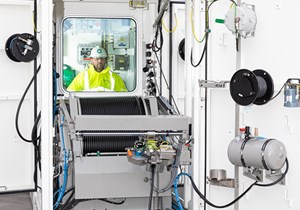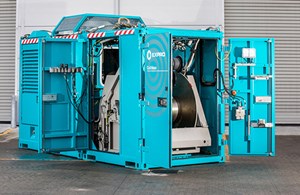Making light work: How technology advances will power growth in light well intervention
In the oil and gas industry, both old and new wells create intervention challenges for operators. As the age of well stocks increases, and well designs and characteristics become ever more complex and challenging, the requirement for effective intervention solutions is growing. Similarly, as new wells are developed, the ability to rapidly lift or remove columns of fluid to enable early production is essential.
Recent high commodity prices and concerns over global supply security have heightened the need for operators to explore efficient intervention options that will both maximize recovery and reduce operational expenditure.
Leading the charge is light well intervention (LWI). In 2019, LWI made up almost 60% of the global well intervention market share, and the demand is rising. It has been estimated the global riserless light well intervention (RLWI) market will grow by more than 5.2% from 2022 to 2027, when it is expected to reach more than $1.856 billion.
There are several benefits to using LWI systems over heavy or medium intervention systems involving deployment of a rig or mobile offshore drilling unit (MODU). For example, the scheduling and deployment of a vessel, rather than a rig, can allow for quicker mobilization and demobilization. The time involved in delivering a rig to the required location and providing all the necessary crew and equipment can be significantly longer than for a ship with crew and equipment already onboard. The potential for a more rapid response time with LWI compared to rig-based intervention can be a critically important factor, if a significant issue occurs with a well that needs urgent attention.
When it comes to the process of intervening in the well, coiled tubing can present several challenges. While coiled tubing can be, and has been, successfully run from vessels, its lack of flexibility, weight and size of units required means it is more suited to deployment from a rig or MODU.
In vessel-based operations, for example, one of the problems encountered with coiled tubing is the motion of the vessel and the sea state heave and swell, which can create fatigue challenges for the tubing’s metallurgy.
Rig-based intervention systems may not be open to the environmental benefits of an LWI system in terms of reduced emissions. The procedures involved in towing a rig to the required location can necessitate the use of several vessels, helicopters, and the rig itself. This compares to a much smaller footprint for single-vessel LWI operations.
The benefits of LWI systems in providing faster solutions and advanced operational efficiency while reducing operating and capital expenses, compared to rig-based heavy intervention, are instigating the development of a range of technologies to support the sector.
One area of focus has been the development of an alternative to the deployment of coiled tubing for well intervention programs. Energy services provider Expro has devised a unique solution to this challenge.
The company recognized that coiled tubing set-ups offered high-rate circulation but are heavy, bulky, and time-consuming to plan and mobilize. In contrast, wireline systems can be run from much smaller units, but do not have a circulation capability. It was recognized that because of a lack of a suitable alternative solution, in some cases the deployment of coiled tubing was overkill for the project’s requirements.
Industry trends have been leading toward the development of larger versions of coiled tubing for bigger operations. However, an opportunity was identified for a smaller-sized solution. The idea was developed to merge the qualities of both coiled tubing and wireline into a new technology, to create a light well circulation system that could be deployed in a wide range of offshore and onshore locations. This hybrid evolution would represent a new generation of well intervention technology.
The CoilHoseTM light well circulation system (LWCS) is an innovative development in light well intervention, providing a more efficient alternative to traditional coiled tubing systems, Fig. 1. The technology merges the qualities of both coiled tubing and wireline by substituting the conventional steel pipe currently in use with a hose. It uniquely integrates the benefits of wireline’s operational efficiency with tubing pumping capabilities.

The system enables rig-less light circulation services from a package with a relatively small footprint compared to coiled tubing. With individual lifts as light as five tonnes, it offers operators an alternative to coiled tubing reels that can be four times that weight. It can be deployed rapidly across all types of installations, both onshore and offshore, including riserless and subsea applications. It enables circulation from a minimum footprint with a small crew. The minimal heavy lift enables the maximization of operational uptime while reducing overall HSE exposure.
A 24-to-48-hr mobilization time and a fast rig-up time of 3 to 4 hrs/critical rig time with lightweight pressure control equipment (PCE) can reduce the amount of downtime for operations while providing rapid intervention capabilities. From an environmental and a risk perspective, less personnel, fewer transport requirements, a smaller footprint, smaller fluid volumes in the tubing, and deployment of the most highly efficient power generators (which are significantly smaller than those used for coiled tubing systems) are all considered benefits.
Utilizing thermoplastic and fiber technology to construct the hoses provides a degree of flexibility unavailable to metal coiled tubing and eliminates cycling fatigue. An integrated services crew structure means multiple tasks can be completed by the same onboard personnel. Several services also can be run from the unit, including standard intervention with slickline or e-line, all from one crew.
Relevant applications for the system include upper completion; subsea safety valve; and Christmas tree clean-out (for calcium carbonate scale/paraffin and asphaltenes); nitrogen gas lift kick-off or unloading of wells; hydrate and debris removal; jetting services; circulation and/or chemical spotting at low-rate pumping; as well as memory logging services.
The technology was first utilized in 2016 and has now been deployed in more than 50 projects for different applications globally. Expro has always had a keen focus on its well intervention offering and identified the opportunity to strengthen its intervention heritage by acquiring the technology in 2019. Since then, the company has continued to further the technology, including the development of the latest generation of CoilHose system designed to enable deployment of the product through a riserless open-water intervention system, Fig. 2. This iteration of the technology was recently used to great success on a new well in the North Sea.

WORLD’S FIRST N2 UNLOADING
The company recently completed a world-first operation by successfully unloading a subsea well for a Norwegian operator with the system, using an RLWI vessel. The deployment of the latest-generation Coilhose technology through a riserless open-water intervention system allowed the unloading of the well with only nine days of vessel time required.
The operator had a newly completed well that had been left with a column of brine in the main wellbore during the completion phase of their operations. The completion fluids were required to be unloaded. After carrying out simulations, it was apparent that a nitrogen (N2) gas lift was necessary to bring the well into production.
The operator was keen to undertake the gas lift from a light well intervention vessel for two reasons. Firstly, the rig that had been used to complete the well was required for another project. Secondly, the RWLI vessel was readily available to the operator, which allowed the project timeline and interfaces onboard to be managed, ensuring success for the project.
The two companies had worked together on projects previously. The operator had been aware of the technology from its earliest developments in Norway and had kept abreast of its development. It had successfully used the technology previously to complete jetting work on some of its assets in Norway. As a result, the operator had gained a good understanding and confidence in the technology and supported Expro’s ability to perform open-water intervention from an RLWI, with a limited footprint and fewer personnel onboard (POB).
The project marked the first deployment of the latest version of the technology at the time. As a result, there was an even greater degree of additional testing, planning and engagement between the two companies than would be normally expected. It must be said that the support from the operator’s subject matter experts—from the planning and testing phases through to the project readiness phase—was exceptional.
A further consideration was that the operator required a hybrid approach to the project. This meant Expro would be working in conjunction with the operator’s preferred wireline vendor, which provided the deployment package that was installed on the vessel. This close collaborative approach involving multiple interfaces allowed Expro to ensure the operator received a fully integrated service delivery platform.
The hose technology was set up and run from the wireline vendor’s deployment unit on the vessel in open water to the subsea system and positioned at a depth of 2,150 m. The well was unloaded over a period of 7 hrs.
Detailed planning in conjunction with the operator at the outset resulted in a textbook deployment delivery for the project, which was completed safely and significantly ahead of time. Originally, the operator had experience with running Coil Tubing from the RWLI and, therefore, understood the timeline required to perform this operation.
Using the alternative hose technology, with only nine days of vessel time required from mobilization to demobilization, and an enhanced rig-up and deployment time, the subsea well was unloaded successfully and brought into full production. This dramatically reduced the project’s duration with associated operational expenditure reductions.
The system’s compact nature with a relatively small footprint required fewer personnel than traditional methods. This helped reduce the overall health and safety risk and the operation’s carbon footprint.
Senior engineer for the RLWI and customer representative, said, “With this recent success, we see that CoilHose is a useful tool for us to handle depleted reservoirs.”
MAKING A MARK
In line with its focus on constantly improving the technology, Expro is working on researching and developing further hose designs to allow more applications within its hydraulic intervention portfolio.
The significant hydraulic challenges of feeding a hose into a pressurized well have led to the company retaining the existing diameter dimensions of 19.5 mm for the ¾-in. version and 23.5 mm for the latest-generation version. However, the composition of the hose has been strengthened to increase its gravity fed deployment depth to approximately 3,000 m and its tubing head pressure capabilities to approximately 2,000 psi. This will increase the operating envelope of the technology to enable operators to intervene in higher-pressure wells and at greater depths.
The company has a strong technology roadmap for the system, and its intention is to continue expanding the working envelope, potentially into mechanical, intelligence, and even cementing workscopes in the future. As more intelligent products enter the market, technologies, such as hoses, DFOS and Slick e-Line, will become more applicable for deployment on older infrastructures and assets.
CONCLUSION
As global acceptance of the technology spreads, and more operators recognize its efficiency, safety, and environmental benefits, more opportunities and applications are becoming available. Alongside other recent intervention technology developments, such as intelligent slickline and coil tubing, hose systems may be regarded as a significant enabler in the evolution of well intervention services. WO
- Applying ultra-deep LWD resistivity technology successfully in a SAGD operation (May 2019)
- Adoption of wireless intelligent completions advances (May 2019)
- Majors double down as takeaway crunch eases (April 2019)
- What’s new in well logging and formation evaluation (April 2019)
- Qualification of a 20,000-psi subsea BOP: A collaborative approach (February 2019)
- ConocoPhillips’ Greg Leveille sees rapid trajectory of technical advancement continuing (February 2019)


